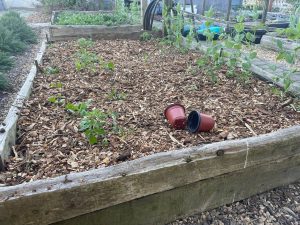
It should be no surprise to anyone that I am a huge fan of Spring. Everything comes back to life and it feels like everything is breathing and growing again. It’s almost like the world has a little bit more energy to give, and I soak it up as much as possible – but my favorite part about spring is gardening. The feeling of growing your own food and being able to store away nutrients and calories for later in the year is something that is hard to beat. Self-sufficiency in today’s world is almost impossible, but even a little bit goes a long way when everything seems to be getting more expensive. For this reason, I do all that I can to squeeze every bit of productivity out of my tiny little slice of Richmond soil.
My gardening season starts early every year with some seeds going into cell packs in the first week of January, where they will spend several months germinating and growing in my basement grow tent. One of the early starters was my Roma tomatoes, as I want them as big as possible for early transplant. This means that I can have a longer growing period resulting in more tomatoes for drying and canning, limiting the amount of commercially-grown and processed tomatoes I have to buy. Once my tomatoes are planted, my raised beds become tangled messes of vines that are almost impenetrable due to the thick vegetation and foliage. It seems impossible to think that there is any way to further squeeze productivity out of those beds, at least until I talked with our resident mycologist, Peter Girardi.
A study was brought to my attention that shows how a symbiotic relationship can be set up with Wine Cap Mushrooms, which give a nutrient boost to the tomatoes, which in turn provide a home for the mushrooms and a separate source of nutrition and productivity from my garden beds. Wine Cap Mushrooms are a choice edible mushroom that are easy to grow on fresh hardwood wood chips that can be applied to garden beds. The beds benefit from the wood chip mulch regardless of mushroom production, as they help hold moisture in the soil and limit weed competition. By adding the mushroom substrate to inoculate the wood chips, degradation of the wood chips is increased and nutrients from the wood chips are released at a higher rate, resulting in better yield from the tomatoes.
Here’s what I did:
- First, we bought our mushroom spawn from SHARONDALE FARMS in the Charlottesville area for less than $30.


- Next, I am lucky enough to have a nearly-endless supply of fresh wood chips at work.

- With the last frost hopefully in our past, my tomatoes were introduced to their new home where my Spinach is finishing up its Spring run.

- A 2 inch thick blanket of fresh hardwood wood chips is applied over the entirety of one 6 by 8 foot raised bed.

- The mushroom substrate block was broken into small clumps and sprinkled evenly over the first layer of mulch.



- A second 2 in thick layer of mulch is then applied to sandwich the mycelium between the mulch layer, and then then it is all watered well.

The biggest concerns regarding the success of this technique is moisture and adequate shade. I already have a watering system set up off of a newly installed 300 gallon rain water tote so I do not have to worry about Chlorine from city water. Also, knowing that my tomatoes always take over their bed, I will have no lack of shade on the mulch.
Even if the mushrooms do not flush, I know that I will be helping the soil in my raised beds, and my watering will be reduced with the addition of mulch. I will be planting my adjacent bed with tomatoes in the exact same way but will not inoculate with mushrooms to determine if there is any difference in tomato yields. This will be a fun project and updates will come over the season!


